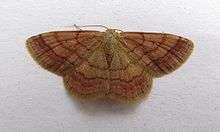Scopula rubiginata
Scopula rubiginata, the tawny wave, is a moth of the family Geometridae. The species was first described by Johann Siegfried Hufnagel in 1767.
| Scopula rubiginata | |
|---|---|
 | |
| Mounted specimen | |
| Scientific classification | |
| Kingdom: | Animalia |
| Phylum: | Arthropoda |
| Class: | Insecta |
| Order: | Lepidoptera |
| Family: | Geometridae |
| Genus: | Scopula |
| Species: | S. rubiginata |
| Binomial name | |
| Scopula rubiginata | |
| Synonyms | |
|
List
| |
Subspecies
Subspecies Scopula rubiginata ochraceata Staudinger, 1901[2] is mostly treated as a species, Scopula ochraceata.
Etymology
The Latin species name rubiginata means "rusty", with reference to the coloration of the wings.
Distribution and habitat
This species is present from the Iberian Peninsula up to the Ural. In the North its range extends to Denmark and Southern Sweden and Finland. It is not present in most of the southern part of the Iberian Peninsula (with the exception of Gibraltar), Sicily and the southern Greek islands.[3] In Morocco it is found in the Atlas mountains. Furthermore, it is also present in North Turkey, the Caucasus and the Crimea. Eastwards, its range stretches through southern Siberia, the northern central Asian mountains up to Mongolia. These moths preferably inhabit sandy terrain, such as sand dunes[4] dry-warm environment, grasslands and heath, at an elevation up to 1,000 metres (3,300 ft) above sea level.
Description
Scopula rubiginata has a wingspan of 16–22 mm.[4] These moths are rather small in size in comparison to other geometrids. They present a rather high variability in basic color and drawings. The basic color depends on the humidity.[5] As a matter of fact wings may be tawny, pale brown, violet-reddish, greyish or straw-coloured, with darker brown or darker reddish, transverse and slightly wavy markings (hence the common name of the species) on the upper sides. The inner transverse line is missing on the hind wings. Similar markings are present on the under sides. The apex of the forewings is rounded. The hindwing margin is uniform, almost round. The fringes are paler than the basic color.
The eggs are approximately cylindrical. The surface is covered with 16 distinct longitudinal ribs. The caterpillars are relatively slender and a bit thicker towards the rear end. The color is variable, ranging from yellowish, brownish, slightly reddish to gray. The ventral side is greenish. The back shows a relatively thin line, but darker than the basic color, The head is relatively small, roundish and slightly reddish. The pupa is brown, with fine bristles.[6][7]
This species is quite similar to Idaea ochrata, but this last species shows a dented hindwing margin.
Biology
The moths fly in one (June to August), two (May to June and July to September)[4] or three (in overlapping generations from April to October) generations depending on the location. These moths are day and night active, but especially from dusk onwards. At night, they come to artificial light sources. The moths were observed on the flowers of the following plants: figworts (Scrophularia canina), small rattle-pail (Rhinanthus minor), yellow mignonette (Reseda lutea), hoary ragwort (Senecio erucifolius), broad-leaved thyme (Thymus pulegioides), alfalfa (Medicago sativa) and carrot (Daucus carota).
The larva feeds on various herbaceous plants, including knotgrass (Polygonum), [4] Thymus glabrescens, Calluna vulgaris, Artemisia campestris, Rumex acetosella, Thymus serpyllum, Medicago lupulina, Vicia, Lotus, Trifolium, Cytisus scoparius, Thalictrum, Galium, Taraxacum officinale[4] and Convolvulus arvensis.[8][9] The partly grown larvae hibernate in the sward. Later they pupate in a cocoon amongst debris.[10]
References
- Sihvonen, Pasi (April 1, 2005). "Phylogeny and classification of the Scopulini moths (Lepidoptera: Geometridae, Sterrhinae)". Zoological Journal of the Linnean Society. 143 (4): 473–530. doi:10.1111/j.1096-3642.2005.00153.x.
- "Catalogue of Life - 2016 Annual Checklist: Search all names". www.catalogueoflife.org. Retrieved 2019-01-03.
- "Scopula (Scopula) rubiginata (Hufnagel, 1767)". Fauna Europaea. Retrieved 2019-01-03.
- "Tawny Wave Scopula rubiginata". UKMoths. Retrieved 2019-01-03.
- Arno Bergmann: Die Großschmetterlinge Mitteldeutschlands. Band 5/1, Spanner Verbreitung Formen und Lebensgemeinschaften. Urania-Verlag, Jena 1955.
- "08054 Scopula rubiginata (Hufnagel, 1767) - Violettroter Kleinspanner". Lepiforum e.V. Retrieved 2019-01-03.
- "Scopula rubiginata, Kimmo´s Lep Site". www.kolumbus.fi. Retrieved 2019-01-03.
- Savela, Markku. "Scopula rubiginata (Hufnagel, 1767)". Lepidoptera and Some Other Life Forms. Retrieved June 9, 2019.
- "Scopula rubiginata (www.pieris.ch © Heiner Ziegler)". www.pieris.ch. Retrieved 2019-01-03.
- "Lepidoptera of Belgium: Scopula rubiginata". www.phegea.org. Retrieved 2019-01-03.
- Axel Hausmann: The Geometrid moths of Europe, 2. Sterrhinae. Apollo Books, Stenstrup 2004, ISBN 87-88757-37-4
| Wikimedia Commons has media related to Scopula rubiginata. |
| Wikispecies has information related to Scopula |
External links